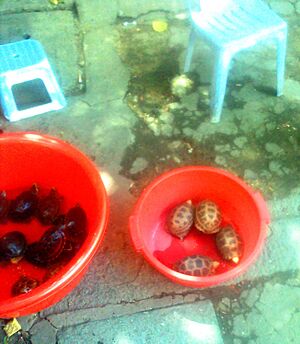Elongated tortoise facts for kids
Quick facts for kids Elongated tortoise |
|
|---|---|
 |
|
| Elongated tortoise in Dusit Zoo | |
| Conservation status | |
| Scientific classification | |
| Genus: |
Indotestudo
|
| Species: |
elongata
|
| Synonyms | |
|
|
The elongated tortoise (Indotestudo elongata) is a special kind of tortoise. You can find it in Southeast Asia and some parts of South Asia.
Contents
About the Elongated Tortoise
The elongated tortoise has a shell that is quite flat. It is more than twice as long as it is deep. The front and back edges of the shell are slightly curved upwards. These edges are very bumpy in young tortoises but smoother in older ones.
The shell has patterns that look like rings, especially on younger tortoises. The tortoise also has a small, narrow shield near its neck. The shield above its tail is usually one piece.
Size and Appearance
Most adult elongated tortoises are about 30 cm (12 inches) long. They usually weigh around 3.5 kg (7 pounds).
Female tortoises tend to be wider and more rounded than males. Males have a much larger tail. The bottom shell of a male (called the plastron) is curved inward. A female's plastron is flat. Females also have longer, more curved back claws. This helps them dig nests for their eggs.
The shell and bottom part of the tortoise are greenish-yellow. Each shield on the shell has an irregular black spot. These spots can be large or small and sometimes hard to see.
Where Elongated Tortoises Live
You can find the elongated tortoise in many countries. These include India, Nepal, Bangladesh, Myanmar (Burma), Laos, Thailand, Cambodia, Vietnam, Western Malaysia, and Southern China.
Tortoises in a Thai Village
In a village called Ban Kok in Thailand, these tortoises live everywhere. This village is about 50 km (31 mi) from Khon Kaen city. For over 200 years, these tortoises have lived peacefully with the villagers. The local people call them tao pek (เต่าเพ็ก).
Threats and Conservation
The elongated tortoise is a critically endangered species. This means its numbers are dropping very quickly in the wild.
The biggest danger to these tortoises is hunting. Many are caught and sold for food markets, especially in China and other parts of East Asia. Some people also wrongly believe that a special mix made from the tortoise's shell can be used as a medicine.
Other problems for the tortoises include their homes being destroyed. Their natural living areas are shrinking. Also, some people illegally collect them to sell as pets.
Elongated Tortoises in Captivity
In their natural homes, these tortoises eat many different kinds of plants. If they are kept as pets, they also need a wide variety of foods. They mostly eat different vegetables and edible leaves. However, they also eat meat, snails, and eggs. Eating these different foods helps them get all the nutrients they need. Just eating vegetables is not enough for them.
These tortoises live in warm, tropical places. They do not do well in cold climates. Tortoises sent to Europe and North America as pets often get sick and die if they are not cared for properly indoors.
They also need a constant supply of water for drinking and bathing. Since they are reptiles, they cannot control their body temperature like humans can. So, they need areas where they can find both sun and shade. This allows them to move around and keep their body temperature just right.




